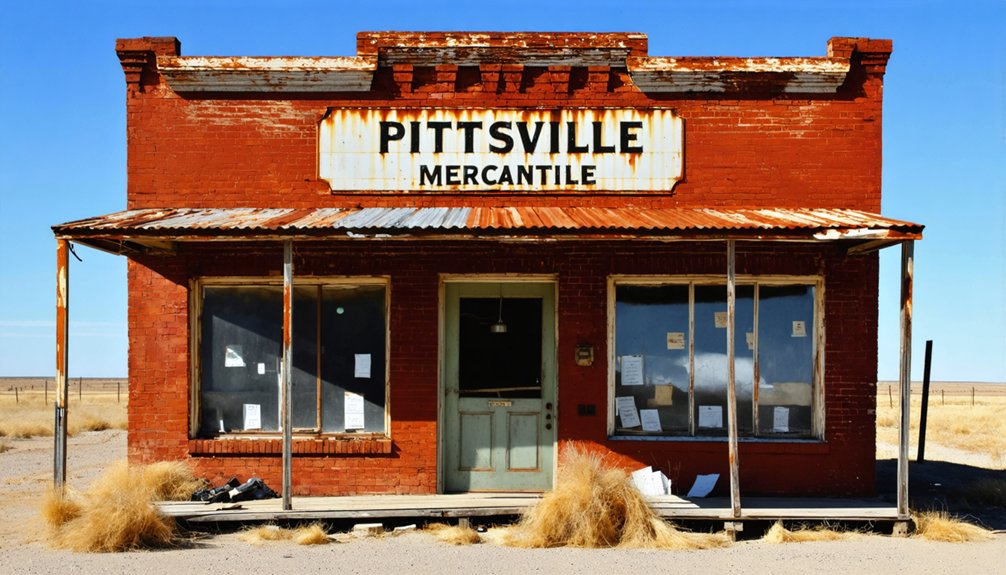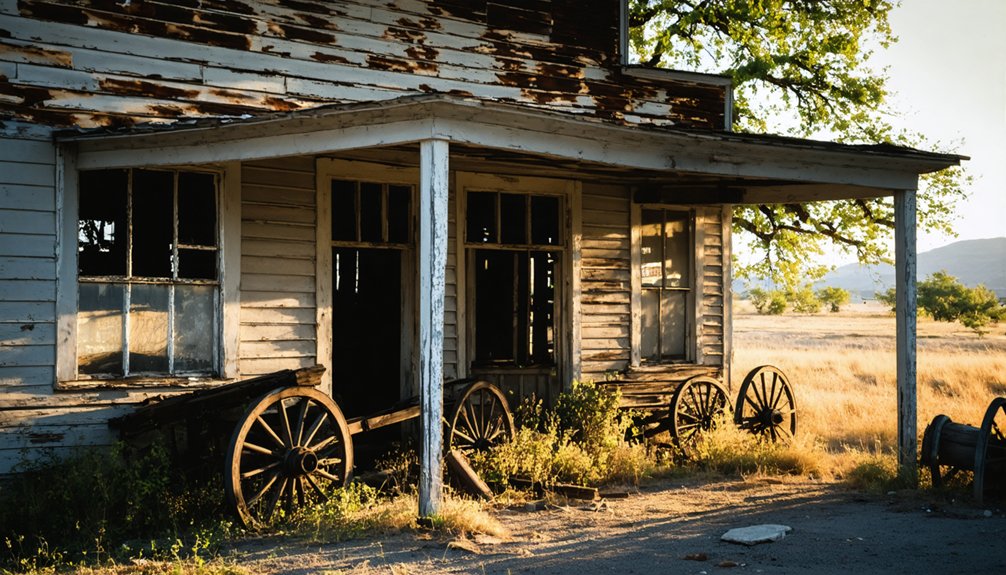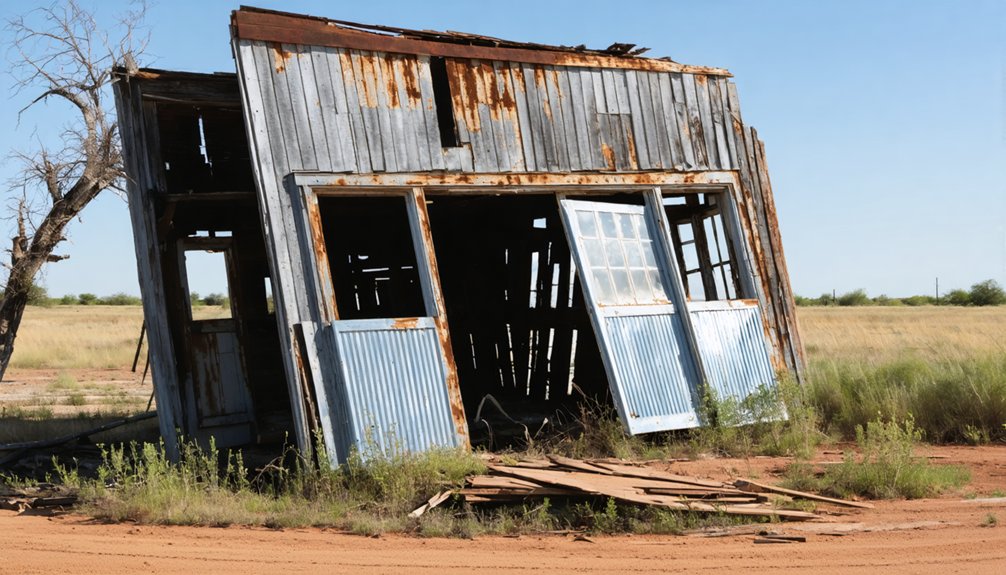You’ll find Pittsville’s ghost town remains three miles north of Fulshear, Texas, where the Pitts family established a thriving community on elevated prairie lands in the 1800s. The settlement peaked at 240 residents by 1860, featuring stores, factories, and a newspaper. After the 1888 railroad bypass and 1889 post office closure, the town declined steadily until its final residents departed in 1947. The site’s abandoned cistern and historical marker hint at deeper stories of pioneer ambition and racial tension.
Key Takeaways
- Pittsville, Texas was established on high ground near the Brazos River, growing to 240 residents by 1860 before becoming a ghost town.
- The town thrived as a commercial hub with factories, a newspaper, and diverse trades until the railroad bypassed it in 1888.
- A racial violence incident at Liberty Hope Church in 1888 triggered social unrest and population decline in the community.
- Economic factors including the 1923 bank closure, Great Depression, and agricultural mechanization contributed to the town’s abandonment.
- The last residents left in 1947, and today only an abandoned cistern and Texas Historical Commission marker remain near Fulshear.
A Town Born From Pioneer Spirit
While the Brazos River posed flooding challenges to early Texas settlers, the pioneering Pitts family established a thriving community on higher ground that would become known as Pittsville. Their pioneer resilience was evident as they opened a store and managed mail distribution, attracting other determined settlers to join them.
You’ll find that by 1860, the town had grown to 240 residents, forming strong community bonds through diverse occupations. Plantation owners, wagoners, carpenters, schoolteachers, and physicians worked alongside brick masons, engineers, ministers, merchants, clerks, wheelwrights, machinists, and artesian well borers. Modern researchers seeking information about this location can find it listed on the disambiguation page for clarity.
Notable families like the Bains, Walkers, Nesbitts, Cumings, Hugginses, Brookshires, Harrises, and Pools helped shape this vibrant settlement, each contributing to the town’s development through their trades and civic engagement.
Early Days Along the Brazos River
Although the fertile Brazos River bottomlands attracted many Texas settlers in the 1840s, the founders of Pittsville wisely chose to establish their community on elevated prairie lands about three miles north of present-day Fulshear.
You’ll find that these pioneer settlers weren’t taking chances with the river’s unpredictable flooding patterns. Instead, they built their town at the strategic crossroads of what’s now Farm Road 359 and Hunt-Jordan Road, creating a safe haven while maintaining easy access to the region’s resources.
The community grew steadily, reaching about 240 residents by 1860. While many worked the land as farmers and ranchers, others pursued diverse trades – from blacksmithing to teaching. The town’s prime location allowed settlers to benefit from the Brazos River’s proximity while avoiding its hazards.
Life in 19th Century Pittsville
Life in nineteenth-century Pittsville bustled with diverse occupations and industries beyond its agricultural base.
You’d find skilled workers like wagoners, carpenters, and brick masons alongside merchants, physicians, and machinists. Local factories produced pickles, cigars, and canned goods, while sawmills and hub-and-spoke mills kept the economy humming. By 1860, the town had grown to include 200 residents.
Community gatherings centered around the Methodist church and local schools, where educational initiatives began with the Pitts family’s first schoolhouse. The town established a two-story academy to further enhance educational opportunities.
The Pitts family schoolhouse laid the foundation for education, while the Methodist church brought neighbors together in faith and fellowship.
You’d catch up on local news through the town newspaper, which launched in 1883 and underwent several name changes. The Pitts family store served as an essential hub for mail distribution and retail, while prominent families like the Bains, Walkers, and Brookshires formed the backbone of this tight-knit community.
The Liberty Hope Church Incident
You’ll find one of the most tragic examples of post-Reconstruction racial violence in the Liberty Hope Church incident of October 13, 1888, when six white Jaybird members confronted two black politicians during a church festival, resulting in Lamar Johnson’s death and Taylor Randon’s wounding.
Like the original churches in Lee County, black congregations often began by holding services in makeshift brush arbors before constructing permanent buildings.
Similar to the church on Fleta Road, which served as a gathering place for its community in the 1890s, the Liberty Hope Church was a central meeting point for local residents before the tragic events unfolded.
The attack exemplified the Jaybirds’ violent campaign to eliminate black political power, known as “Woodpeckers,” from Fort Bend County’s government.
After the incident, Randon fled to Houston, while the Jaybirds’ intimidation tactics succeeded in further weakening black political representation in the region.
Political Tensions Erupt
During a late evening gathering at Liberty Hope Church on October 13, 1888, political violence erupted when six white Jaybird members confronted two local Black politicians, forever changing Pittsville’s trajectory.
The attackers, including Dick Preston and Theophilus Simington of the prominent Simonton family, called out Taylor Randon and Lamar Johnson from the church. What followed was a brutal display of racial violence that left Johnson dead and Randon wounded. Like the recent tragedy where four people were killed at a Grand Blanc church, this violent attack shattered the community’s sense of safety in their place of worship. Much like Hope Fellowship’s recent moral failures by church leaders, the incident severely damaged trust within the religious community.
This attack exemplified the Jaybirds’ systematic political suppression of Black citizens and their white allies, known as Woodpeckers.
You’ll find this incident’s impact rippled through generations, as Randon fled to Houston, and many Black residents abandoned the area. The Jaybirds’ victory secured white political dominance in Fort Bend County until the mid-20th century.
Jaybird-Woodpecker Power Struggle
While political tensions simmered throughout Fort Bend County in 1888, the Liberty Hope Church incident marked a violent turning point in the Jaybird-Woodpecker struggle.
On October 13, six armed Jaybird members targeted Black political leaders at a church festival, calling out Lamar Johnson and Taylor Randon. The ensuing political violence left Johnson dead and Randon wounded. Like the Sunday service massacre, this attack targeted innocent people during what should have been a peaceful church gathering.
The attackers included Dick Preston, Walter Sims, Theophilus Simington, Seth Miller, Fred Fuller, and George Lass.
While arrests followed, historical records suggest they faced minimal consequences. This act of racial intimidation served the Jaybirds’ broader campaign to eliminate Black political participation in Fort Bend County.
Randon fled to Houston after the attack, and the incident successfully intimidated the local Black community, furthering the Jaybirds’ goal of establishing exclusive white control over local government.
Aftermath and Social Impact
After the Liberty Hope Church incident, profound social and legal repercussions rippled through Fort Bend County.
You’ll find that the shooting, which claimed Lamar Johnson’s life and wounded Taylor Randon, sparked immediate fear within the black community. Many residents fled the area, seeking safety elsewhere, while those who remained faced heightened racial tensions and political instability. The tragedy brought forth emotional tributes as 250 grieving attendees gathered to remember those affected.
The arrest of six white men connected to the Jaybirds exposed the deep-seated racial divisions of the post-Civil War era. Similar to the more recent First Baptist Church tragedy, this incident became a defining moment in the state’s history of violence at places of worship.
While community resilience emerged in the face of violence, meaningful racial healing proved elusive. The incident’s legacy continues to serve as a sobering reminder of Texas’s complex history of racial conflict, standing as a significant marker in the broader struggle for equality during the Reconstruction period.
Economic Struggles and Community Changes
You’ll notice Pittsville’s economic decline accelerated after the 1888 railroad bypass, which shifted trade activities to nearby Fulshear and diminished the town’s commercial importance.
The loss of the post office in 1889 further weakened Pittsville’s economic foundation, disrupting essential communication and business links that had sustained the community since the 1870s.
A steady exodus of residents followed, with families like the Nesbitts being among the last to depart in 1947, marking the final chapter of this once-thriving prairie settlement.
Bank Sale Impact
When Pittsville Bank shuttered its doors in 1923 after just four years of operation, the closure dealt a devastating blow to the town’s economic foundation.
You’ll find that this banking crisis deeply affected the local farming community, who’d relied on the institution for credit and financial services since its 1919 opening.
The bank’s failure triggered a domino effect that you can trace through Pittsville’s decline. Without access to local banking, farmers struggled to maintain cash flow and secure loans.
The town’s financial stability eroded as residents were forced to conduct business with distant institutions, leading to economic leakage. This vacuum of financial services accelerated the town’s transformation, as families gradually moved away and businesses, despite valiant efforts by residents like Harry McKay, couldn’t sustain the community’s former liveliness.
Farm Market Decline
The 1888 construction of the San Antonio and Aransas Pass Railroad south of Pittsville marked the beginning of the town’s economic unraveling. As farmers sought better market accessibility, they relocated to railroad towns like Fulshear, devastating local agriculture and commerce.
- The post office’s closure in 1889 signaled Pittsville’s diminishing role as a market hub.
- Cotton and livestock price drops during the Great Depression crippled remaining farm operations.
- Dust Bowl conditions in the 1930s further destabilized agricultural income.
- New Deal programs couldn’t revive small-scale farming as mechanization took hold.
- General stores and blacksmith shops closed as farmers shifted to larger towns.
Population Migration Patterns
During Pittsville’s gradual decline between 1888 and 1947, residents steadily migrated to nearby Fulshear and other railroad-connected towns in search of better economic opportunities.
You’ll find that this migration trend reflected a broader rural depopulation pattern across America, as people sought modern amenities and better-connected locations.
The loss of essential services accelerated Pittsville’s exodus. As families departed, the local school, stores, and post office closed their doors.
Despite having a diverse community of farmers, stockraisers, and skilled tradespeople, the town couldn’t sustain itself without railroad access.
The final chapter of Pittsville’s populated history came in 1947 when its last residents, Mrs. Alice Nesbitt and her daughter Doris, left the area, marking the end of a once-thriving rural Texas community.
Notable Families and Their Legacy
Several prominent families shaped Pittsville’s development and cultural fabric throughout its existence, with the Pitts family serving as the town’s cornerstone through their establishment of the first general store and mail distribution center.
You’ll find these families’ influence woven throughout the town’s history:
- A.R. and Amanda Pitts’ strategic choice of elevated prairie land protected early settlers from Brazos River flooding.
- The Martin family’s seven-generation presence maintained essential community institutions, particularly the Enon church.
- The Bains’ contributions to farming and settlement helped establish the agricultural foundation.
- The Huggins influence strengthened the core population of early settlers.
- The Fulshear infrastructure developments, including a school, cotton gin, and flour mill, enhanced regional commerce.
The Final Years of a Dying Town

When the San Antonio and Aransas Pass Railroad bypassed Pittsville in 1888-1889, it marked the beginning of the town’s steady decline into abandonment.
You’d have witnessed the town’s community resilience as it fought against economic forces, but the lack of rail access proved insurmountable. The closure of the post office in 1889 signaled deeper troubles ahead.
Through historical reflections, you can trace how Pittsville’s once-vibrant population of 240 dwindled as residents sought opportunities in railroad-connected Fulshear.
The town’s infrastructure gradually crumbled – general stores closed, the two-story school emptied, and farms became less viable.
What Remains Today
Today’s visitor to Pittsville’s former site will find little evidence of the once-thriving community that called this place home.
Located along FM 359 near Hunt Road, this ghost town exploration reveals only an abandoned cistern and a cluster of trees marking where buildings once stood.
Time has left only scattered trees and a lone cistern to mark where this forgotten Texas town once thrived.
While historical preservation efforts have placed a Texas Historical Commission marker near Fulshear, the site itself remains largely undeveloped prairie.
- No structures remain standing at the original town location
- You’ll find no designated parking or interpretive signs on-site
- The area is accessible via public roads for self-guided exploration
- Local historical organizations maintain only archival records
- The surrounding region faces increasing suburban development from Greater Houston’s expansion
The site, though historically significant, offers minimal physical connections to its past as an active community.
Historical Significance in Fort Bend County

Pittsville earned its place in Fort Bend County history as an essential commercial and civic hub during Texas’s mid-19th century development.
You’ll find its heritage deeply rooted in the strategic decision-making of early settlers who chose elevated prairie lands over flood-prone areas, establishing a thriving rural community of 240 residents by 1860.
The town’s diverse economy supported various professions, from merchants to artisans, while its post office served as an important communication link for the Brazos River valley.
You can trace Pittsville’s influence through its Confederate involvement and the prominent citizens who shaped regional politics.
Though the railroad’s bypass eventually led to its decline, Pittsville’s legacy lives on as a reflection of frontier ingenuity and community building in early Texas.
Frequently Asked Questions
What Natural Disasters or Weather Events Impacted Pittsville’s Development?
You’d face flood damage in the Brazos River bottoms, which influenced initial settlement on higher ground, though periodic flooding still affected trade routes and drought impact challenged agricultural sustainability.
Were There Any Famous Outlaws or Criminal Incidents Besides Church Shooting?
While you’ll find famous outlaws throughout Texas, there’s no documented evidence of notable criminal incidents or outlaw activity specific to Pittsville beyond the tragic church shooting.
What Native American Tribes Originally Inhabited the Pittsville Area?
You’ll find the Caddo were the primary Native Tribes in this area, establishing their cultural heritage roughly 1,000 years before Europeans arrived. The Comanche and Lipan Apache later influenced the region’s dynamics.
Did Pittsville Have Its Own Newspaper or Local Media Outlet?
Like a shadow without its object, you won’t find local journalism records for Pittsville itself. Historical archives show residents relied on The Pittsburg Gazette, founded in 1876, for their news coverage.
What Industries or Businesses, Besides Farming, Sustained Early Pittsville’s Economy?
You’d find general stores, blacksmith shops, garages, wheelwrights, and a millinery shop thriving alongside essential repair services, though there’s no evidence of a cotton gin or lumber mill operating there.
References
- https://jocomohistory.org/pittsville/
- https://en.wikipedia.org/wiki/Pittsville
- https://robertgordon2.substack.com/p/from-prairie-to-ghost-town-the-story
- https://kids.kiddle.co/Pittsville
- https://en.wikipedia.org/wiki/List_of_ghost_towns_in_Texas
- http://lifeonthebrazosriver.com/Pittsville
- http://lifeonthebrazosriver.com/lifeyesterday.htm
- https://www.youtube.com/watch?v=LrW4u6GGAf4
- https://www.pittsburgtx.gov/294/History
- https://pittsvillewi.gov/history/



